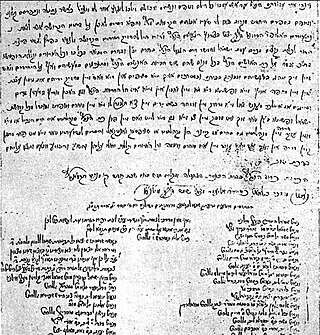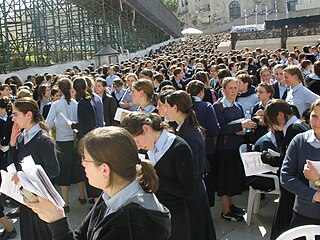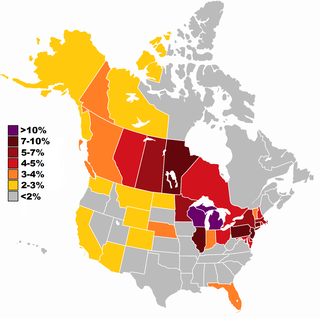Related Research Articles

Hasidism, sometimes spelled Chassidism, and also known as Hasidic Judaism, is a religious movement within Judaism that arose as a spiritual revival movement in the territory of contemporary Western Ukraine, then Poland, during the 18th century, and spread rapidly throughout Eastern Europe. Today, most of those affiliated with the movement, known as hassidim, reside in Israel and in the United States.

Haredi Judaism consists of groups within Orthodox Judaism that are characterized by their strict interpretation of religious sources and their accepted halakha and traditions, in opposition to more accommodating or modern values and practices. Its members are usually referred to as ultra-Orthodox in English; however, the term "ultra-Orthodox" is considered pejorative by many of its adherents, who prefer terms like strictly Orthodox or Haredi. Haredi Jews regard themselves as the most religiously authentic group of Jews, although other movements of Judaism disagree.

Chabad, also known as Lubavitch, Habad and Chabad-Lubavitch, is an Orthodox Jewish Hasidic dynasty. Chabad is one of the world's best-known Hasidic movements. It is one of the largest Hasidic groups as well as one of the largest Jewish religious organizations in the world. Unlike most Haredi groups, which are self-segregating, Chabad mainly operates in the wider world and it caters to secularized Jews.

A Rebbe or Admor is the spiritual leader in the Hasidic movement, and the personalities of its dynasties. The titles of Rebbe and Admor, which used to be a general honor title even before the beginning of the movement, became, over time, almost exclusively identified with its Tzaddikim.

Satmar is a Hasidic group founded in 1905 by Grand Rebbe Joel Teitelbaum, in the city of Szatmárnémeti, Hungary. The group is an offshoot of the Sighet Hasidic dynasty. Following World War II, it was re-established in New York.

Misnagdim was a religious movement among the Jews of Eastern Europe which resisted the rise of Hasidism in the 18th and 19th centuries. The Misnagdim were particularly concentrated in Lithuania, where Vilnius served as the bastion of the movement, but anti-Hasidic activity was undertaken by the establishment in many locales. The most severe clashes between the factions took place in the latter third of the 18th century; the failure to contain Hasidism led the Misnagdim to develop distinct religious philosophies and communal institutions, which were not merely a perpetuation of the old status quo but often innovative. The most notable results of these efforts, pioneered by Chaim of Volozhin and continued by his disciples, were the modern, independent yeshiva and the Musar movement. Since the late 19th century, tensions with the Hasidim largely subsided, and the heirs of Misnagdim adopted the epithet Litvishe or Litvaks.
Neo-Hasidism, Neochassidut, or Neo-Chassidus, is an approach to Judaism in which people learn beliefs and practices of Hasidic Judaism, and incorporate it into their own lives or prayer communities, yet without formally joining a Hasidic group. Over the 20th century neo-Hasidism was popularized by the works of writers such as Hillel Zeitlin, Martin Buber, Abraham Joshua Heschel, Lawrence Kushner, Zalman Schachter-Shalomi, and Arthur Green.
Religion in Canada encompasses a wide range of beliefs and customs that historically has been dominated by Christianity. The constitution of Canada refers to God and the monarch carries the title of Defender of the Faith, however Canada has no official church and the government is officially committed to religious pluralism. Freedom of religion in Canada is a constitutionally protected right, allowing individuals to assemble and worship without limitation or interference.

Litvaks or Lita'im are Jews with roots in the territory of the former Grand Duchy of Lithuania. The term is sometimes used to cover all Haredi Jews who follow an Ashkenazi, non-Hasidic style of life and learning, whatever their ethnic background. The area where Litvaks lived is referred to in Yiddish as ליטע Lite, hence the Hebrew term Lita'im (לִיטָאִים).
Canadian Jews, whether by culture, ethnicity, or religion, form the fourth largest Jewish community in the world, exceeded only by those in Israel, the United States and France. As of 2021, Statistics Canada listed 335,295 Jews in Canada. This total would account for approximately 1.4% of the Canadian population.

Bais Yaakov is a genericized name for full-time Haredi Jewish elementary and secondary schools for Jewish girls throughout the world.
The Demographics of Montreal concern population growth and structure for Montreal, Quebec, Canada. The information is analyzed by Statistics Canada and compiled every five years, with the most recent census having taken place in 2021.

Polish Canadians are citizens of Canada with Polish ancestry, and Poles who immigrated to Canada from abroad. At the 2016 Census, there were 1,106,585 Canadians who claimed full or partial Polish heritage.
Federation CJA is a Canadian Jewish organization that raises and distributes funds by facilitating and overseeing the delivery of services and programs.

The 2011 Canadian census was a detailed enumeration of the Canadian population on May 10, 2011. Statistics Canada, an agency of the Canadian government, conducts a nationwide census every five years. In 2011, it consisted of a mandatory short form census questionnaire and an inaugural National Household Survey (NHS), a voluntary survey which replaced the mandatory long form census questionnaire; this substitution was the focus of much controversy. Completion of the census is mandatory for all Canadians, and those who do not complete it may face penalties ranging from fines to prison sentences.
Reuben Joshua Poupko is a Canadian-American Orthodox rabbi. He has served as spiritual leader of the Beth Israel Beth Aaron Congregation synagogue in Montreal since 1986, and sits as co-chair of the Centre for Israel and Jewish Affairs' Canadian Rabbinic Caucus.
Allan L. Nadler is Wallerstein Professor Emeritus of Religious Studies and Former Director of the Jewish Studies Program at Drew University in Madison, New Jersey.
Toronto's Jewish community is the most populous and one of the oldest in the country, forming a significant part of the history of the Jews in Canada. It numbered about 240,000 in the 2001 census, having overtaken Montreal in the 1970s. As of 2011, the Greater Toronto Area is home to 188,710 Jews. The community in Toronto is composed of many different Jewish ethnic divisions, reflecting waves of immigration which started in the early 19th century. Canada's largest city is a centre of Jewish Canadian culture, and Toronto's Jews have played an important role in the development of the city.
Montreal's Jewish community is one of the oldest and most populous in the country, formerly first but now second to Toronto and numbering about 82,000 in Greater Montreal according to the 2021 census. The community is quite diverse and is composed of many different Jewish ethnic divisions that arrived in Canada at different periods of time and under differing circumstances.

Meshulim Feish Segal Lowy II was the fourth Grand Rebbe of the Tosh Hasidic dynasty.
References
- ↑ Shefa, Sheri. "Intermarriage Data from U.S. Poll Cause Stir Here". Canadian Jewish News. October 14, 2013.
- ↑ Studies by Shahar from the Berman Jewish Policy Archive
- ↑ Shahar, Charles, & Tina Rosenbaum. The Jewish Community of Toronto: 2001 Census Analysis Series. UJA Federation of Greater Toronto, UIA Federations Canada. Toronto: Canada. 2003.
- ↑ Data bank summary
- 1 2 The study's main report